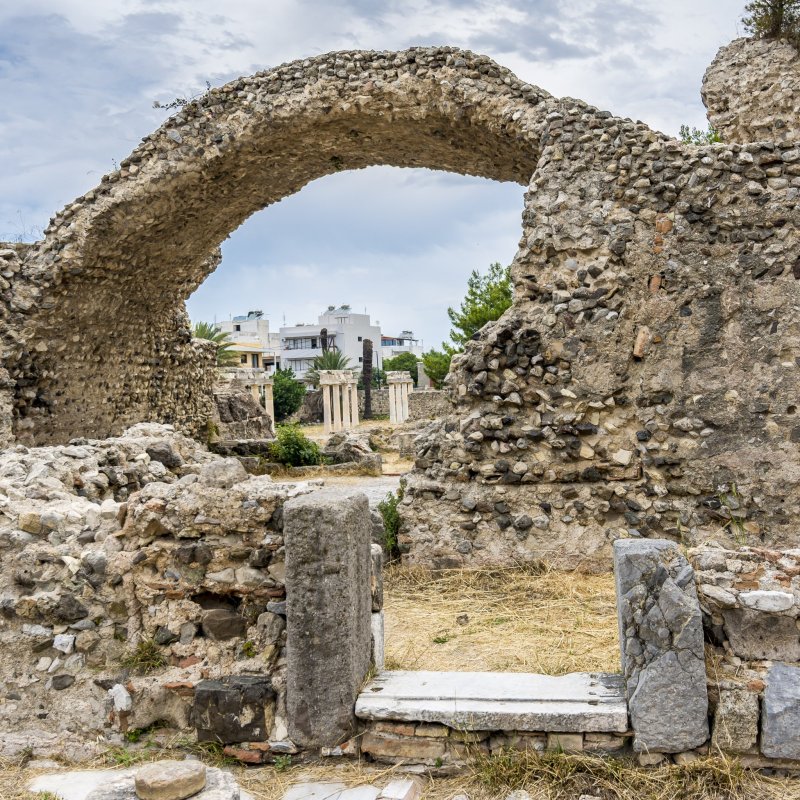
Close to the shore of Turkey in the beautiful Aegean Sea, the Greek island of Kos has a fascinating history. To get there, you’ll fly into Kos International Airport, the only airport on the medium-size Greek island, or go by ferry if you’re traveling from another Greek island.
Videos by TravelAwaits
As with most Greek islands, there’s plenty to see on Kos, but whatever you choose to do there, your visit will include archaeological sites and well-preserved ruins. When you feel like pulling away from the fantastic beaches on Kos to get to know the island’s past, you’ll find a wealth of museums and ruins spanning centuries of Kos history.
Here are six of the island’s best historic sites to explore.

1. Casa Romana
The Casa Romana, or Roman Villa, is an incredibly well-preserved house from the era of the Roman occupation of the island. It was discovered and excavated following the earthquake of 1933, when Italians once again occupied the island and began rebuilding the damaged areas. The owners of the house are not known, but they must have been pretty important. The house has 36 rooms, and the surviving mosaics and statues tell a story of prosperity and success. The mosaics form intricate pictures of tigers, panthers, and deer, and one of the statues bears the inscription “he who repels evil.” All of these are in incredible condition, considering how old they are. The house dates to the late second century and provides insight into what life was like for the island’s wealthy at the time.
Tickets cost 6 euros, so this is a very reasonably priced attraction. Note that the house is closed on certain days of the week.

2. Western Archaeological Zone
The Western Archaeological Zone is a fascinating site of discovery in western Kos Town. This area of town was abandoned in the Middle Ages, although it’s unclear why. The area is very well preserved and houses some incredible finds, only discovered following an earthquake in 1933. The remains of a gymnasium and swimming pool offer insight into how important competitive games have always been to the Greeks, while the public baths show how life here changed when the Romans held power on the island. The baths used a heating system of steam carried through pipes beneath the floors, demonstrating some of the advanced technology that could be found in Kos at that time. Stunning mosaics and pillars illustrate what the area would have looked like in its glory days.
This amazing site is just a 10-minute walk from the center of Kos Town, so it’s easy to get to without transport from the center of town.

3. Roman Odeon
Just a 5-minute walk from the Western Archaeological Zone is the Roman Odeon. This is where musical performances and poetry recitals were held, and it was the venue where the senate met. The Odeon was built in the second century and would have held around 750 people. It was damaged by an earthquake and rebuilt by the Romans, and then was rescued again by an Italian archaeologist who found a haul of statues hidden away in the ruins when it was excavated. This is an incredible historic site with a story of destruction and rebirth laid out in stone. It was originally roofed, but you’ll need your imagination to envisage that now.
The Odeon is still in use and hosts various performances and events throughout the year. It’s free to visit, but there is very little information about its history on-site.

4. Castle Of Antimachia
To the south of Kos Town, in the center of the island, is the Castle of Antimachia. As you approach the castle, an impressive ring of stone will greet you on the hill. As you get closer, you’ll find that this is an abandoned and remote ruin. In 1302, when Kos became a protectorate of Venice, this castle was built to defend the island from invasion by pirates. There are two lovely old churches here as well as ruined houses where those living here were once kept safe. It’s a quiet and off-the-beaten-track spot, and a peaceful place to wander away from the crowds.
Be careful when walking the dusty paths and the ramparts of the castle, since the stones have crumbled in places, and the paths are uneven underfoot. It’s a couple of miles from the main road, so you’ll need your own transport or to take a taxi. Be aware that there are no amenities at this site.

5. Asklepion
The Asklepion is a sacred hospital from ancient Greek times that dates to around 400 B.C. This incredible museum is situated close to the village of Platani and is set in beautiful surroundings with spectacular views. The hospital is a fascinating example of early Greek medicine and is where patients underwent hypnosis and water therapy as well as other treatments practiced by priests at the time. The hospital is a rare and unique chance to see an ancient Greek sanatorium and is one of only four like it left in the whole of Greece. Named after the Greek god of medicine, Asclepius, this important building tells us much about early medicine and how it was practiced.
The site is huge, and you could easily spend an hour wandering around the temple area, the waiting rooms, and the triage areas. There’s a lot of information to help you find your way. I thought it was a bit expensive at 8 euros — especially since there is a look-but-don’t-touch policy for much of the ruins. There’s a bus stop close by, and you buy your tickets at a booth before making the 10-minute uphill walk to the site, so be ready for a stroll!

6. Agios Stefanos
The ruins of Agios Stefanos were once two early Christian basilicas named after Saint Stephen. The site is about a 15-minute walk from Kefalos and close to the Kamari Marina. This popular area is home to the most photographed beach on Kos — a clue as to how beautiful the landscape is. These well-preserved ruins include pillars and intricate mosaics and are a great example of early Christian life on the island. Located right next to the beach, it’s a beautiful spot to relax in and have a swim while appreciating the history of the island.
The ruins of Agios Stefanos are also something of a hidden gem. There are no signs up or information plaques telling you what this is, so if you didn’t know, you might overlook it. Most people come here for the beach and the water sports, and although the area does get busy, the ruins themselves are less frequented than the beach and the harbor, so you can have them to yourself if you’re lucky.
What To Know Before You Go
Many of these historic sites are in and around Kos Town, but it’s also very easy to travel to the other sites around the island. It only takes about an hour to drive the length of Kos, and the buses are easy and fun to use, though they only run about once an hour. There are plenty of taxis available, too, so wherever you are staying on the island, you can easily visit all of these sites.
Visit Kos outside of the high season — especially avoiding the Hippocratia Festival, Kos’s main national holiday — if you want space and quiet to enjoy the historic sites in peace. Many of the historic sites are ruins and have little or no information available on-site, so be sure to do your research before you get there.
